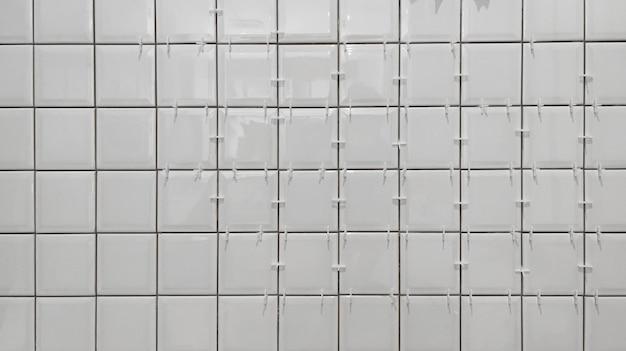Mosaic tiles are a popular choice for adding a creative touch to our homes, transforming ordinary spaces into stunning works of art. But when it comes to installation, many questions arise. One of the common queries is whether spacers are necessary for mosaic tiles. In this blog post, we will delve into this topic and provide you with all the information you need to know before starting your mosaic tile project.
Have you ever wondered what you should stick mosaic tiles with? Or how much space should be left between each tile? Can tiles be installed without the use of spacers? We will tackle these questions and more. Additionally, we will discuss various techniques to prevent tiles from sagging and slipping during installation. Furthermore, we will provide insights on choosing the right thinset and alternative options to tile spacers. So, let’s dive in and explore the world of mosaic tiles!
Do You Need Spacers For Mosaic Tiles
Mosaic tiles are a fantastic way to add character and personality to any space. Whether you’re redecorating your bathroom or sprucing up your kitchen backsplash, mosaic tiles offer a wide range of design possibilities. But when it comes to installing these small and intricate tiles, one question often arises: do you really need spacers?
The Case for Spacers
Spacers are small, usually plastic, devices that help maintain a consistent gap between tiles during the installation process. These gaps, known as grout lines, play an essential role in ensuring the structural integrity and aesthetic appeal of the finished mosaic. Spacers help to keep the tiles evenly spaced, allowing for a uniform grout line throughout the entire surface.
Having spacers in place also helps prevent the tiles from shifting or sliding as the adhesive dries. This is particularly important when working with mosaic tiles, as their smaller size and irregular shapes can make it challenging to achieve a seamless installation without the use of spacers.
Why Some People Skip Spacers
Now, let’s be honest here. It’s not all doom and gloom if you decide to go against the norm and skip using spacers for your mosaic tiles. Some experienced DIYers and professionals might argue that spacers are unnecessary for certain mosaic tile installations. They might claim that their keen eye for detail and steady hand can produce perfectly aligned tiles without the use of spacers.
While this may be true for some individuals who possess exceptional skill and patience, it’s essential to note that using spacers is still the recommended method for most people, especially those who are new to tile installation. As the saying goes, “Better safe than sorry!”
The Middle Ground: Spacer Alternatives
If you’re not a fan of the traditional plastic spacers but still want to achieve that professional look, there are alternative options you can consider. Some tile installers prefer using cross-shaped tile spacers that fit directly between each tile corner. These spacers offer more flexibility in adjusting the spacing and can be easily removed before grouting.
Another option that has gained popularity in recent years is the use of tile leveling systems. These systems employ reusable clips and wedges to ensure that each tile is perfectly leveled and spaced. While they may require a bit more investment upfront, tile leveling systems can save you time and effort by simplifying the installation process.
In summary, while it may be tempting to skip using spacers when installing mosaic tiles, it’s generally best to follow the recommended guidelines. Spacers help maintain consistent grout lines, prevent shifting or sliding of tiles, and ultimately contribute to a professional-looking finished product. However, if you have the expertise and confidence to tackle a spacer-less installation, there are alternative options available to help you achieve your desired result. So embrace the beauty and creativity of mosaic tiles, and let the spacers do their job to make your project shine!
FAQ: Do You Need Spacers For Mosaic Tiles
If you’re planning a mosaic tile project and find yourself pondering whether or not you need spacers, you’ve come to the right place. In this FAQ-style guide, we’ll address all your queries about spacers for mosaic tiles. From the adhesive to the thickness of mortar, we’ve got you covered. So, let’s dive right in!
What do you stick mosaic tiles with
When it comes to sticking those tiny, mesmerizing mosaic tiles, you have various options. You can use tile adhesive or thinset mortar. The choice depends on your project and personal preference. Just make sure to choose a product suitable for your tile material, surface, and application method.
How much space should be between mosaic tiles
Spacing is crucial for achieving a professional finish in your mosaic masterpiece. The recommended spacing between mosaic tiles is typically 1/8 of an inch (3mm). This allows room for grout, ensuring your tiles don’t end up cramped and overcrowded.
Can tile be installed without spacers
While some daredevils might attempt installing tiles without spacers, we wouldn’t recommend it. Spacers are essential for maintaining consistent gaps between tiles, ensuring they are evenly spaced and aligned. Don’t risk a wonky-looking mosaic that could haunt your dreams—use spacers!
How do you keep tiles from sagging
Ah, the age-old struggle of tiles defying gravity! To prevent the dreaded ‘sagging tiles’ situation, it’s crucial to have a supportive surface. Make sure your substrate is properly prepared, level, and free from any defects. Additionally, using the correct adhesive and following manufacturer guidelines on curing times will help keep those tiles in their place.
How much thinset do I need for mosaic tile
For mosaic tile installation, you’ll need a sufficient amount of thinset mortar. As a general guideline, aim for a thickness of about 1/8 to 3/16 of an inch (3 to 5mm) when applying the thinset. However, always refer to the manufacturer’s instructions and follow their guidelines for the specific thinset brand and tile material you are using.
What can I use instead of tile spacers
If you find yourself in a tight spot without tile spacers, fear not! You can get creative and use various alternatives. Toothpicks, popsicle sticks, or even business cards can serve as makeshift spacers. Just remember to remove them before the adhesive sets and the project reaches completion.
Do subway tiles have built-in spacers
Subway tiles, with their timeless charm, can indeed make your walls sing. However, they don’t come with built-in spacers. To achieve the classic subway tile look, you’ll need to use regular tile spacers. So grab your spacers, embrace that vintage vibe, and get tiling!
Can you mosaic without grout
Ah, grout—the magical substance that brings our tiles together. While some mosaic enthusiasts may dream of a groutless life, it’s not recommended. Grout provides stability, prevents moisture penetration, and enhances the overall aesthetic of your mosaic. So let’s face it—grout is the glue that keeps our mosaic hearts happy!
What is the best way to grout mosaic tiles
Grouting is where the magic truly happens! To ensure a smooth and successful grouting experience, follow these steps:
- After allowing the adhesive to cure, remove any excess adhesive or debris from the mosaic surface.
- Choose a grout color that complements your mosaic design and mix it according to the manufacturer’s instructions.
- Apply the grout diagonally using a grout float, ensuring the grout fills the gaps between tiles.
- After about 10-20 minutes, wipe away excess grout with a damp sponge, moving diagonally across the tiles to avoid dislodging the grout from its rightful place.
- Once the grout has fully cured, give your mosaic a final wipe to reveal its true beauty.
How do you stop tile slipping
Tiles slipping and sliding? That’s a nightmare nobody wants. To prevent tiles from going rogue during installation, use tile spacers to maintain precise spacing and support each tile until the adhesive cures. Once the adhesive has set, those tiles won’t be going anywhere!
What size trowel do I use for mosaic tile
Choosing the right trowel size is essential for a successful mosaic tile installation. For most mosaic projects, a 3/16 inch (5mm) V-notch trowel is a popular choice. However, always consider your tile size, shape, and substrate when selecting the trowel. Remember, happy tiles start with the right trowel!
Do mosaic tiles need grout
Yes, indeed! Grout is the unsung hero in the world of mosaics. It provides strength, stability, and an overall refined look to your mosaic project. Without grout, your tiles may shift, crack, or lose their charm over time. So, embrace the power of grout and make your mosaic sparkle!
Why are spacers used in tiles
Spacers, the tiny superstar heroes of tiling, serve multiple purposes. They ensure consistent tile spacing, allow room for grout, and aid in alignment during the installation process. They are the secret sauce that transforms a messy tiling journey into a delightful and visually pleasing masterpiece!
How thick should mortar be for mosaic tile
The mortar thickness for mosaic tile installation is vital for a stable and long-lasting result. Aim to apply the thinset mortar with a thickness of about 1/8 to 3/16 of an inch (3 to 5mm). This thickness provides enough adhesive to support and adhere your mosaic tiles firmly to the substrate.
What can I use for mosaic backing
For your mosaic to truly shine, it needs the right backing. There are several options to choose from, including wood, mesh, or even concrete boards. Each material has its pros and cons, so consider factors like your project’s location, size, and desired flexibility before settling on the perfect mosaic backing.
Does wall tile need to be supported
Absolutely! Proper support is essential for wall tiles, just like emotional support is essential after watching a heart-wrenching movie. Ensure your walls have a sturdy and adequately prepared substrate, such as cement board or drywall, to guarantee a solid foundation for your tile installation.
How do I protect my outdoor mosaic
Outdoor mosaics face the elements head-on, so they need a little extra protection. Make sure to seal your outdoor mosaic with a weatherproof sealant or tile and grout sealer. This will provide a protective barrier against rain, heat, and other outdoor challenges, helping your mosaic stay vibrant and beautiful for years to come.
What size trowel should I use for 12×12 tile
For your lovely 12×12 tiles, grab a 1/4 inch square notched trowel to spread the adhesive evenly. This trowel size will ensure adequate coverage and a solid bond between your tiles and substrate. Remember, happy tiles make for happy spaces!
Are mosaic tiles hard to install
Fear not, intrepid DIYers! Mosaic tiles may appear daunting, but with proper preparation and a dash of courage, you can conquer the mosaic kingdom. Start small, practice your techniques, and take your time. Before you know it, you’ll be a mosaic master, turning ordinary surfaces into breathtaking works of art!
With these frequently asked questions about mosaic tile installation and spacers, you’re now equipped to embark on your tiling adventure. Remember to follow the proper installation techniques, use spacers for precise spacing, and embrace the power of grout. Happy tiling and may your mosaic dreams come true!

